tow SKODA SUPERB 2009 2.G / (B6/3T) Owner's Guide
[x] Cancel search | Manufacturer: SKODA, Model Year: 2009, Model line: SUPERB, Model: SKODA SUPERB 2009 2.G / (B6/3T)Pages: 294, PDF Size: 21.33 MB
Page 83 of 294
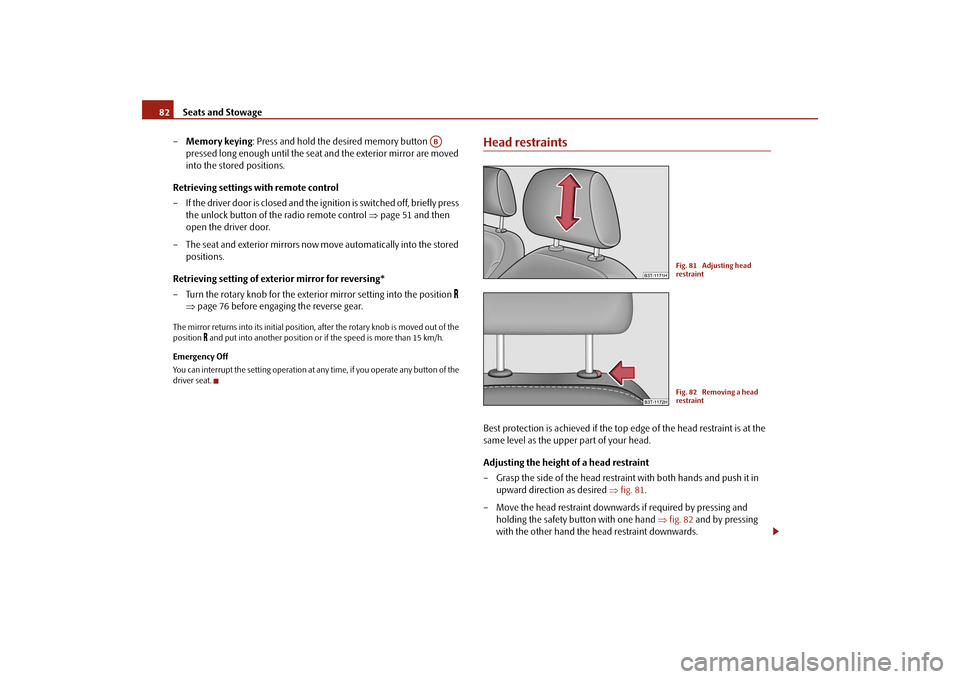
Seats and Stowage
82
–
Memory keying
: Press and hold the desired memory button
pressed long enough until the seat and the exterior mirror are moved into the stored positions.
Retrieving settings with remote control – If the driver door is clos
ed and the ignition is switched off, briefly press
the unlock button of the radio remote control
⇒
page 51 and then
open the driver door.
– The seat and exterior mirrors now move automatically into the stored
positions.
Retrieving setting of exterior mirror for reversing* – Turn the rotary knob for the exterior mirror setting into the position
⇒
page 76 before engaging the reverse gear.
The mirror returns into its initial position,
after the rotary knob is moved out of the
position
and put into another position or if the speed is more than 15 km/h.
Emergency Off You can interrupt the setting operation at an
y time, if you operate any button of the
driver seat.
Head restraintsBest protection is achieved if the top
edge of the head restraint is at the
same level as the upper part of your head. Adjusting the height of a head restraint – Grasp the side of the head restraint with both hands and push it in
upward direction as desired
⇒
fig. 81
.
– Move the head restraint downwards if required by pressing and
holding the safety button with one hand
⇒
fig. 82
and by pressing
with the other hand the head restraint downwards.
AB
Fig. 81 Adjusting head restraintFig. 82 Removing a head restraint
s2dk.1.book Page 82 Wednesday, April 8, 2009 12:23 PM
Page 84 of 294
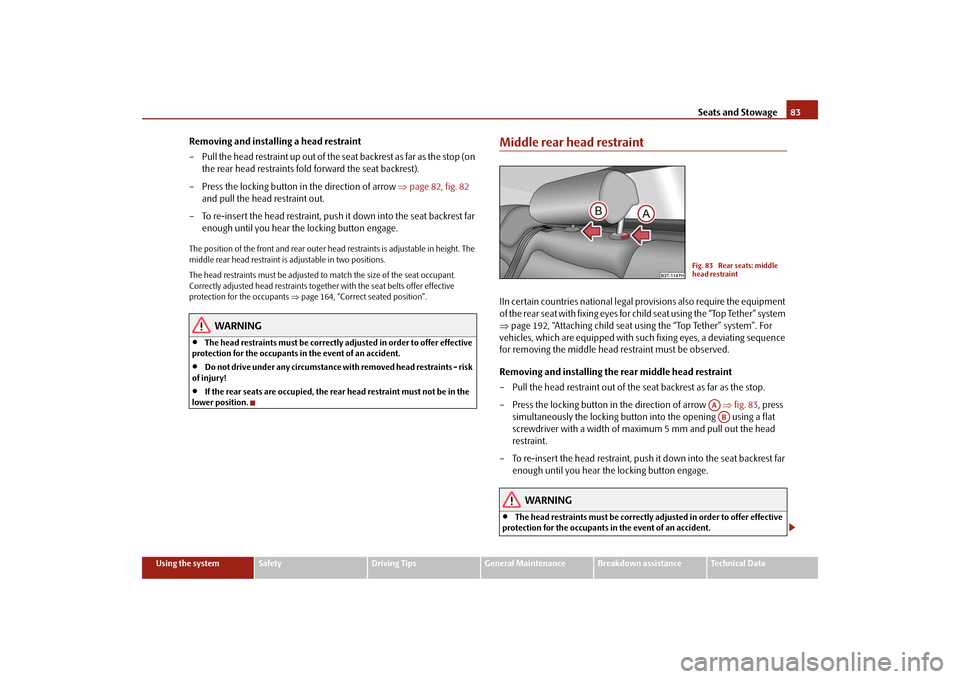
Seats and Stowage
83
Using the system
Safety
Driving Tips
General Maintenance
Breakdown assistance
Technical Data
Removing and installing a head restraint – Pull the head restraint up out of the seat backrest as far as the stop (on
the rear head restraints fold forward the seat backrest).
– Press the locking button in the direction of arrow
⇒
page 82, fig. 82
and pull the head restraint out.
– To re-insert the head restraint, push it down into the seat backrest far
enough until you hear the locking button engage.
The position of the front and rear outer head
restraints is adjustable in height. The
middle rear head restraint is adjustable in two positions. The head restraints must be adjusted to
match the size of the seat occupant.
Correctly adjusted head restraints together with the seat belts offer effective protection for the occupants
⇒page 164, “Correct seated position”.
WARNING
•
The head restraints must be correctly
adjusted in order to offer effective
protection for the occupants in the event of an accident.•
Do not drive under any circumstance with removed head restraints - risk
of injury!•
If the rear seats are occupied, the rear head restraint must not be in the
lower position.
Middle rear head restraintIIn certain countries national legal pr
ovisions also require the equipment
of the rear seat with fixing eyes for child seat using the “Top Tether” system ⇒
page 192, “Attaching child seat using the “Top Tether” system”. For
vehicles, which are equipped with such fixing eyes, a deviating sequence for removing the middle head restraint must be observed. Removing and installing the rear middle head restraint – Pull the head restraint out of the seat backrest as far as the stop. – Press the locking button in the direction of arrow
⇒
fig. 83
, press
simultaneously the locking button into the opening using a flat screwdriver with a width of maximum 5 mm and pull out the head restraint.
– To re-insert the head restraint, push it down into the seat backrest far
enough until you hear the locking button engage.
WARNING
•
The head restraints must be correctly adjusted in order to offer effective
protection for the occupants in the event of an accident.
Fig. 83 Rear seats: middle head restraint
AAAB
s2dk.1.book Page 83 Wednesday, April 8, 2009 12:23 PM
Page 85 of 294

Seats and Stowage
84
•
Do not drive under any circumstance with removed head restraints - risk
of injury!•
If the rear seats are occupied, the rear head restraint must not be in the
lower position.Rear seatsFolding the seat backrest forwards
The luggage compartment can be increased in size by folding the seat backrests forward. Folding the seat backrests forward – Before folding the seat backrests forwards, you must adapt the posi-
tion of the front seats in such a way that they are not damaged by the folded seat backrests.
9)
– Unlock the seat backrest by pressing the unlocking handle
⇒
fig. 84
and fold it completely forwards.
Put the seat backrests into the original position – Install the head restraint in th
e slightly lifted seat backrest.
– Place the rear lateral seat belt
behind the edge of the side trim
panel
⇒
fig. 85
.
– Then push the seat backrest back into the upright position until the
securing knob clicks into place - check by pulling on the seat backrest.
– Make sure that the red pin is covered
⇒
fig. 84
.
WARNING
•
The belts and the belt locks must be in their original position after folding
back the seat backrests - they must be ready to use.•
The seat backrests must be securely interlocked in position so that no
objects in the luggage compartment ca
n slide into the passenger compart-
ment if there is sudden braking - risk of injury!•
Pay attention that the seat backrests are correctly interlocked. It is only
then that the three-point seat belt for the middle seat can reliably fulfil its function.
WARNING (continued)
Fig. 84 Unlock the seat back- restFig. 85 Lock the seat back-rest
9)If the front seats are too far back, we recommend that you have the rear head restraints re-moved before the seat backrests are folded forward. Store the removed head restraints insuch a way that they cannot be damaged or soiled. Please refer to the guidelines
⇒page 86.
AA
AC
AB
s2dk.1.book Page 84 Wednesday, April 8, 2009 12:23 PM
Page 86 of 294

Seats and Stowage
85
Using the system
Safety
Driving Tips
General Maintenance
Breakdown assistance
Technical Data
•
Before folding the seat backrest back into the secure position, place the
rear lateral seat belt behind the edge of the side trim panel. Take suitable measures to prevent that
the seat belt is jammed between the seat backrest
and the side trim panel and is thus damaged.Rear seat armrest– You can fold down the armrest to enhance occupant comfort
⇒
fig. 86
.
Seat heaters*You can electrically heat the seat ba
ckrests and the surfaces of the front
seats and the two outer rear seats. – You can switch on and regulate the
seat heating of the driver or front
passenger seat by pressing the surfac
e of the regulator at the point at
which the symbol is located
⇒
fig. 87
.
– You can switch on and adjust the heat
ers of the left or right rear seats
by pressing the regulator
⇒
fig. 88
.
– With one press, you can switch the
heating to highest intensity which
is indicated by the lighting up of the three warning lights in the switch.
WARNING (continued)
Fig. 86 Rear seats: Armrest
Fig. 87 Dash panel: Regu- lator for front seat heatingFig. 88 Centre console at rear: Regulator for heating the rear seats
s2dk.1.book Page 85 Wednesday, April 8, 2009 12:23 PM
Page 87 of 294
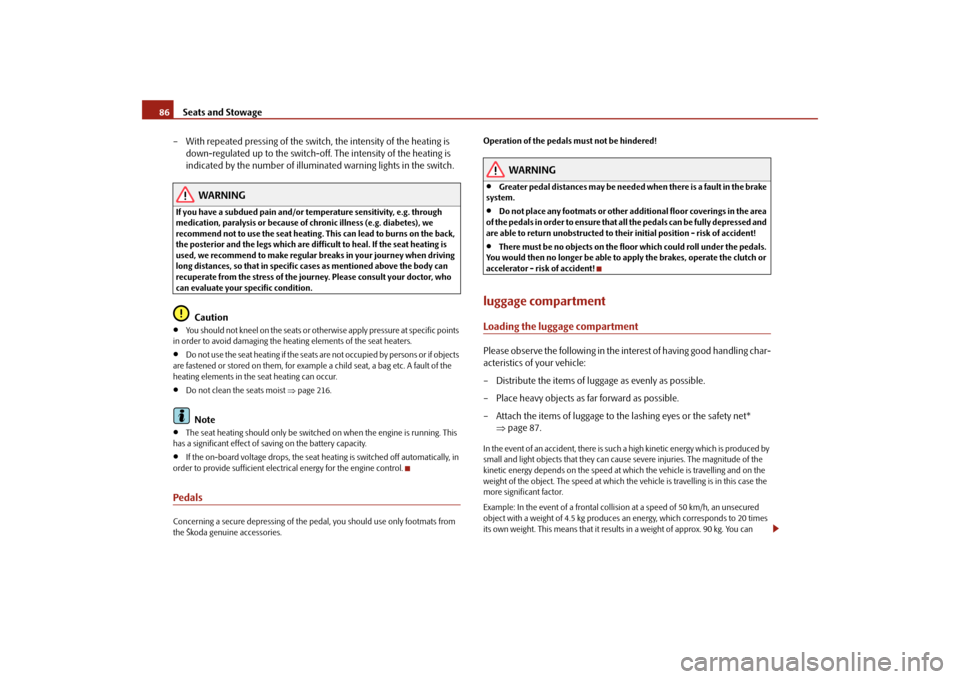
Seats and Stowage
86
– With repeated pressing of the switch, the intensity of the heating is
down-regulated up to the switch-off. The intensity of the heating is indicated by the number of illuminated warning lights in the switch.
WARNING
If you have a subdued pain and/or temperature sensitivity, e.g. through medication, paralysis or because of chronic illness (e.g. diabetes), we recommend not to use the seat heating. This can lead to burns on the back, the posterior and the legs which are diff
icult to heal. If the seat heating is
used, we recommend to make regular br
eaks in your journey when driving
long distances, so that in specific cases as mentioned above the body can recuperate from the stress of the journey. Please consult your doctor, who can evaluate your specific condition.
Caution
•
You should not kneel on the seats or otherwise apply pressure at specific points
in order to avoid damaging the heating elements of the seat heaters.•
Do not use the seat heating if the seats are not occupied by persons or if objects
are fastened or stored on them, for exampl
e a child seat, a bag etc. A fault of the
heating elements in the seat heating can occur.•
Do not clean the seats moist
⇒page 216.
Note
•
The seat heating should only be switched
on when the engine is running. This
has a significant effect of sa
ving on the battery capacity.
•
If the on-board voltage drops, the seat
heating is switched off automatically, in
order to provide sufficient electrical energy for the engine control.PedalsConcerning a secure depressi
ng of the pedal, you should use only footmats from
the Škoda genuine
accessories.
Operation of the pedals must not be hindered!
WARNING
•
Greater pedal distances may be needed when there is a fault in the brake
system.•
Do not place any footmats or other additional floor coverings in the area
of the pedals in order to ensure that all the pedals can be fully depressed and are able to return unobstructed to thei
r initial position - risk of accident!
•
There must be no objects on the floor which could roll under the pedals.
You would then no longer be able to
apply the brakes, operate the clutch or
accelerator - risk of accident!luggage compartmentLoading the luggage compartmentPlease observe the following in the inte
rest of having good handling char-
acteristics of
your vehicle:
– Distribute the items of luggage as evenly as possible. – Place heavy objects as far forward as possible.– Attach the items of luggage to the lashing eyes or the safety net*
⇒
page 87.
In the event of an accident, there is such a
high kinetic energy which is produced by
small and light objects that they can caus
e severe injuries. The magnitude of the
kinetic energy depends on the speed at wh
ich the vehicle is travelling and on the
weight of the object. The speed at which the
vehicle is travelling
is in this case the
more significant factor. Example: In the event of a frontal collision at a speed of 50 km/h, an unsecured object with a weight of 4.5 kg produces
an energy, which corresponds to 20 times
its own weight. This means that it results in a weight of approx. 90 kg. You can
s2dk.1.book Page 86 Wednesday, April 8, 2009 12:23 PM
Page 88 of 294

Seats and Stowage
87
Using the system
Safety
Driving Tips
General Maintenance
Breakdown assistance
Technical Data
imagine the injuries that can occur, if this “bullet” is flying through the interior compartment and hits an occupant.
WARNING
•
Store the objects in the luggage comp
artment and attach them to the
lashing eyes.•
Loose objects in the passenger compartment can be thrown forward
during a sudden manoeuvre or in case
of an accident and can injure the
occupants or other oncoming traffic. This risk is still increased, if the objects which are flying around are hit by a depl
oyed airbag. In this case, the objects
which are thrown back can injure the occupants - hazard.•
Please note that the handling properti
es of your vehicle may be affected
when transporting heavy objects as a result of the displacement of the centre of gravity. The speed and style
of driving must be adjusted accord-
ingly.•
The items carried in the luggage compar
tment should be stored in such
a way that no objects are
able to slip forw
ard if there are any sudden driving
or braking manoeuvres undertaken - risk of injury!•
Never drive with the boot lid fully opened or slightly ajar otherwise
exhaust gases may get into the interior of the vehicle - risk of poisoning!•
On no account exceed the permissi
ble axle loads and the permissible
gross weight of the vehi
cle - risk of accident!
•
Never transport occupants in the luggage compartment!Caution
Please ensure that the heating elements of the rear window heater are not damaged as a result of objects sliding in this area.
Note
Tyre pressure must be adjusted to the load
⇒page 235, fig. 210
.
Lashing eyesEyes are located on the sides of the loading area for lashing the goods to be loaded. You can also attach a floor fixing net*
to these eyes for lashing small objects.
WARNING
•
The load to be transported must be fixed in place in such a way that it
cannot move during the journey and when braking.•
If the items of luggage or objects ar
e attached to the lashing eyes with
unsuitable or damaged lashing straps,
injuries can occur in the event of
braking manoeuvres or accidents. In
order to prevent the items of luggage
being thrown forward, always use suit
able lashing straps which are firmly
attached to the lashing eyes.
Fig. 89 Luggage compart- ment: Lashing eyes
s2dk.1.book Page 87 Wednesday, April 8, 2009 12:23 PM
Page 89 of 294

Seats and Stowage
88
Fixing nets - Net programme*Fixing examples for fixing
net as vertical pocket
⇒page 88, fig. 90
, floor fixing net
and horizontal pocket
⇒fig. 91
.
The fixing nets* are stored in the right side storage compartment of the luggage compartment.
WARNING
The permissible load of the side nets
is 3.5 kg. Heavy objects are not secured
sufficiently - risk of injury and net damage!
Caution
Do not place any objects with sharp edges in the nets - risk of net damage.Folding hooksFolding hooks for attaching small items of luggage, such as bags etc., are provided on both sides of the luggage compartment
⇒fig. 92
.
An item of luggage weighing up to 10 kg can be attached to the hook.Fixing floor covering of the luggage compartment
Fig. 90 Fixing net: Vertical pocketFig. 91 Fixing net: Floor fixing net and horizontal pocket
Fig. 92 Luggage compart-ment: folding hooksFig. 93 Luggage compart-ment: Fixing of the floor covering
s2dk.1.book Page 88 Wednesday, April 8, 2009 12:23 PM
Page 90 of 294

Seats and Stowage
89
Using the system
Safety
Driving Tips
General Maintenance
Breakdown assistance
Technical Data
A loop is located on the floor covering of the luggage compartment
⇒fig. 93
. When
handling the spare whee
l, you can raise the floor covering and fix it on a hook at the
luggage compartment cover.Luggage net*The luggage net is designed for the tranportation of lighter objects.
WARNING
•
In the storage net you must only store objects (up to a total weight of 1.5
kg). Heavy objects are not secured sufficiently - risk of injury!•
No objects with sharp edges should be
stored in the luggage net, because
they can damage the luggage net.
The luggage compartment cover You can use the luggage compar
tment cover behind the head
restraints for storing
light and soft items.
The luggage compartment cover can be
removed as required if one must
transport bulky goods. – Unhook the support straps on the boot lid
⇒
fig. 95
.
– Place the cover on the side supports. – Pull the cover out of the holder
horizontally to the rear.
– Install again by pushing the luggage compartment cover forwards into
the holder and hanging the suppo
rt straps on the boot lid.
You can stow the removed luggage compartment cover behind the rear seat back- rest.
WARNING
No objects should be placed on the
luggage compartment cover, the vehicle
occupants could be endangered if th
ere is sudden braking or the vehicle
collides with something.
Fig. 94 Luggage compart- ment: Luggage net
Fig. 95 Removing the luggage compartment coverA1
A2
A2
A1
s2dk.1.book Page 89 Wednesday, April 8, 2009 12:23 PM
Page 91 of 294
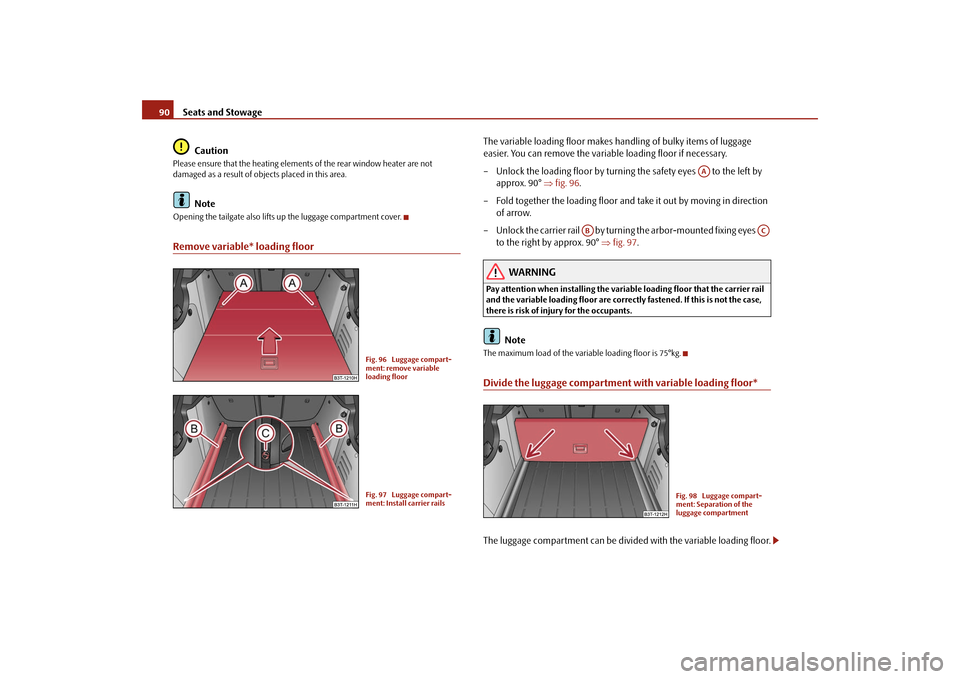
Seats and Stowage
90
Caution
Please ensure that the heating elements of the rear window heater are not damaged as a result of objects placed in this area.
Note
Opening the tailgate also lifts up the luggage compartment cover.Remove variable* loading floor
The variable loading floor makes handling of bulky items of luggage easier. You can remove the variable loading floor if necessary. – Unlock the loading floor by turning the safety eyes to the left by
approx. 90°
⇒
fig. 96
.
– Fold together the loading floor and take it out by moving in direction
of arrow.
– Unlock the carrier rail by turning the arbor-mounted fixing eyes
to the right by approx. 90°
⇒
fig. 97
.
WARNING
Pay attention when installing the variable loading floor that the carrier rail and the variable loading floor are correc
tly fastened. If this is not the case,
there is risk of injury for the occupants.
Note
The maximum load of the variable loading floor is 75°kg.Divide the luggage compartmen
t with variable loading floor*
The luggage compartment can be divided with the variable loading floor.
Fig. 96 Luggage compart- ment: remove variable loading floorFig. 97 Luggage compart-ment: Install carrier rails
AA
AB
AC
Fig. 98 Luggage compart-ment: Separation of the luggage compartment
s2dk.1.book Page 90 Wednesday, April 8, 2009 12:23 PM
Page 92 of 294
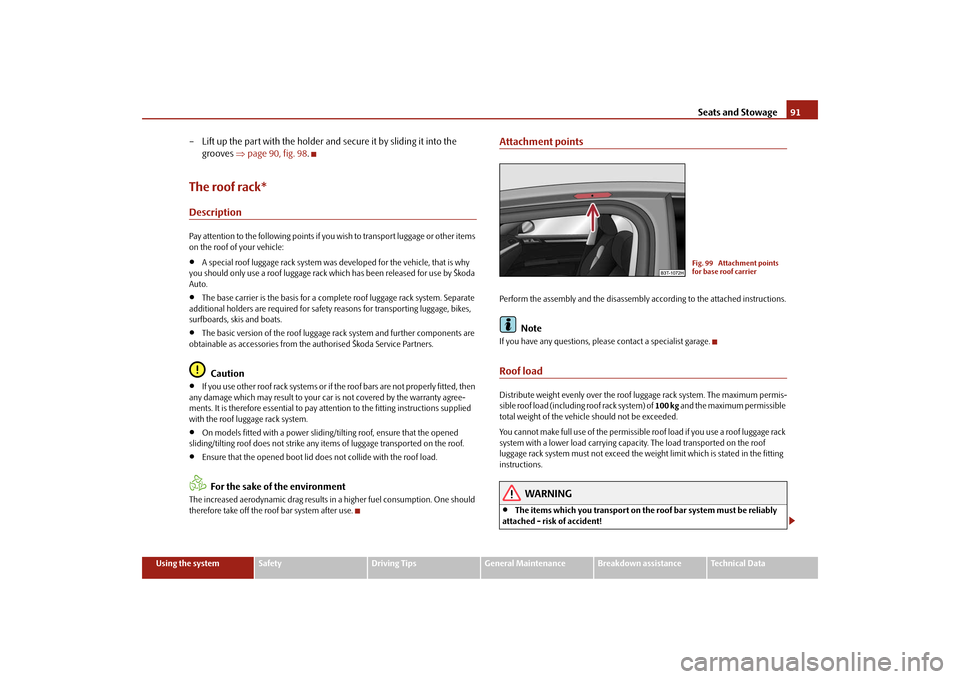
Seats and Stowage
91
Using the system
Safety
Driving Tips
General Maintenance
Breakdown assistance
Technical Data
– Lift up the part with the holder and secure it by sliding it into the
grooves
⇒
page 90, fig. 98
.
The roof rack*DescriptionPay attention to the following points if you wish to transport luggage or other items on the roof of your vehicle:•
A special roof luggage rack system was
developed for the vehicle, that is why
you should only use a roof luggage rack which has been released for use by Škoda Auto.•
The base carrier is the basis for a comple
te roof luggage rack system. Separate
additional holders are required for safety reasons for transporting luggage, bikes, surfboards, skis and boats.•
The basic version of the roof luggage ra
ck system and further components are
obtainable as accessories from th
e authorised Škoda Service Partners.
Caution
•
If you use other roof rack systems or if the roof bars are not properly fitted, then
any damage which may result to your ca
r is not covered by the warranty agree-
ments. It is therefore essential to pay attention to the fitting instructions supplied with the roof luggage rack system.•
On models fitted with a power sliding/tilting roof, ensure that the opened
sliding/tilting roof does not strike any items of luggage transported on the roof.•
Ensure that the opened boot lid do
es not collide with the roof load.
For the sake of the environment
The increased aerodynamic drag results in a higher fuel consumption. One should therefore take off the roof bar system after use.
Attachment pointsPerform the assembly and the disassembly according to the attached instructions.
Note
If you have any questions, plea
se contact a specialist garage.
Roof loadDistribute weight evenly over the roof luggage rack system. The maximum permis- sible roof load (including roof rack system) of
100 kg
and the maximum permissible
total weight of the vehicl
e should not be exceeded.
You cannot make full use of th
e permissible roof load if you use a roof luggage rack
system with a lower load carrying capa
city. The load transported on the roof
luggage rack system must not exceed the weight limit which is stated in the fitting instructions.
WARNING
•
The items which you transport on the roof bar system must be reliably
attached - risk of accident!
Fig. 99 Attachment points for base roof carrier
s2dk.1.book Page 91 Wednesday, April 8, 2009 12:23 PM